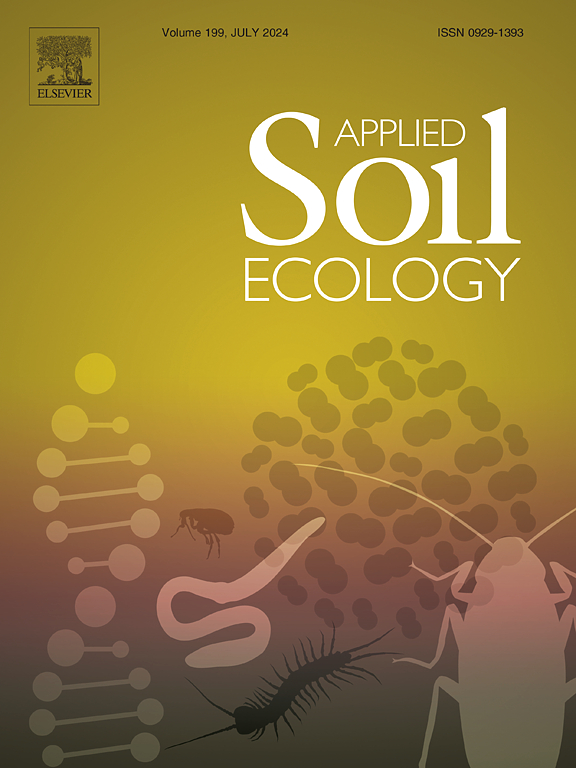草甸草原土壤细菌坏死体碳和真菌坏死体碳对氮沉降的不同响应
IF 5
2区 农林科学
Q1 SOIL SCIENCE
引用次数: 0
摘要
微生物坏死块碳(MNC)是土壤有机碳(SOC)积累和稳定的关键贡献者。然而,氮素沉降对草地MNC动态和有机碳固存的影响尚不清楚。采用8个施肥梯度(0、15、30、50、100、150、200和300 kg N ha−1年−1年),在黄芩针茅草原进行了为期12年的多级施氮试验。结果表明,MNC在土壤有机碳中所占比例高达60%,在富氮条件下其贡献显著增强。结果表明,黄芩草原真菌坏死团碳(FNC)占MNC的75% ~ 82%。FNC浓度、FNC/SOC比值和FNC/ BNC比值在N30处理时达到峰值,之后逐渐下降。细菌坏死团碳(BNC)浓度和BNC/SOC比值沿施氮梯度呈上升趋势,在N150 ~ N300处理中显著升高。利用13C脉冲标记方法,我们追踪了微生物碳流:新吸收的13C最初主要由快速生长的r-战略细菌和灌木菌根真菌(AMF)主导,然后逐渐转移到生长缓慢的腐养真菌和放线菌。这种微生物演替与氮诱导的土壤养分有效性变化密切相关。施氮改变了土壤pH、养分有效性和矿物质含量,驱动了微生物群落组成和酶活性的变化。这些因素与BNC积累的增加及其对SOC的贡献密切相关,而FNC则表现出微不足道的响应。长期施氮显著提高了死体积累系数(NAC)和微生物碳利用效率(CUE)。回归分析显示,BNC含量、BNC对SOC的贡献、NAC和CUE呈显著正相关,而FNC和FNC对SOC的贡献不受直接影响。结构方程模型(SEM)也表明,CUE和Fe、Al含量的增加直接促进了BNC的积累,但对FNC没有直接影响。我们的研究结果表明,N添加主要通过加速细菌更替和改变BNC稳定机制来驱动坏死团块碳动力学和SOC稳定。GP细菌在这些过程中起着核心作用。研究结果表明,氮沉降通过加速土壤转换和矿物结合优先稳定BNC,从根本上重塑了草原有机碳的持久性。本研究为微生物坏死池对氮沉降的差异响应提供了新的见解。本文章由计算机程序翻译,如有差异,请以英文原文为准。
Different responses of soil bacterial necromass carbon and fungal necromass carbon to nitrogen deposition in meadow steppe
Microbial necromass carbon (MNC) is a key contributor to the accumulation and stabilization of soil organic carbon (SOC). However, the effects of nitrogen (N) deposition on MNC dynamics and SOC sequestration in grasslands remain poorly understood. We conducted a 12-year, multi-level N addition experiment with eight fertilization gradients (0, 15, 30, 50, 100, 150, 200, and 300 kg N ha−1 yr−1) in a Stipa baicalensis steppe to simulate N deposition. Our results revealed that MNC constituted up to 60 % of SOC, significantly enhancing its contribution under N enrichment. We found that fungal necromass carbon (FNC) accounted for 75 % to 82 % of MNC in the S. baicalensis steppe. However, we observed that the concentrations of FNC, the FNC/SOC ratio, and the FNC/ BNC ratio peaked in the N30 treatment and gradually decreased thereafter. The concentration of bacterial necromass carbon (BNC) and the BNC/SOC ratio showed an increasing trend along the N addition gradient, significantly increasing in the N150 ~ N300 treatments. Using a 13C pulse-labeling approach, we tracked microbial carbon flow: newly assimilated 13C was initially dominated by fast-growing r-strategist bacteria and arbuscular mycorrhizal fungi (AMF), then progressively transferred to slow-growing saprotrophic fungi and actinobacteria. This microbial succession was tightly coupled to N-induced shifts in soil nutrient availability. N addition altered the soil pH, nutrient availability, and mineral content, driving changes in microbial community composition and enzyme activities. These factors were strongly associated with increased accumulation of BNC and its contribution to SOC, whereas FNC exhibited a negligible response. Long-term N addition significantly increased the necromass accumulation coefficient (NAC) and microbial carbon use efficiency (CUE). Regression analyses revealed significant positive correlations between BNC content, the contribution of BNC to SOC, NAC, and CUE while FNC and the contribution of FNC to SOC were not directly affected. The structural equation modeling (SEM) also demonstrated that increased CUE and higher Fe and Al contents directly enhanced BNC accumulation but did not directly affect FNC. Our results showed that N addition predominantly drives necromass carbon dynamics and SOC stabilization through accelerating bacterial turnover and altering BNC stabilization mechanisms. GP bacteria play a central role in these processes. Our findings demonstrate that N deposition preferentially stabilizes BNC through accelerated turnover and mineral association, fundamentally reshaping SOC persistence in grasslands. This study provides new insights into the differential responses of microbial necromass pools to N deposition.
求助全文
通过发布文献求助,成功后即可免费获取论文全文。
去求助
来源期刊

Applied Soil Ecology
农林科学-土壤科学
CiteScore
9.70
自引率
4.20%
发文量
363
审稿时长
5.3 months
期刊介绍:
Applied Soil Ecology addresses the role of soil organisms and their interactions in relation to: sustainability and productivity, nutrient cycling and other soil processes, the maintenance of soil functions, the impact of human activities on soil ecosystems and bio(techno)logical control of soil-inhabiting pests, diseases and weeds.
 求助内容:
求助内容: 应助结果提醒方式:
应助结果提醒方式:


